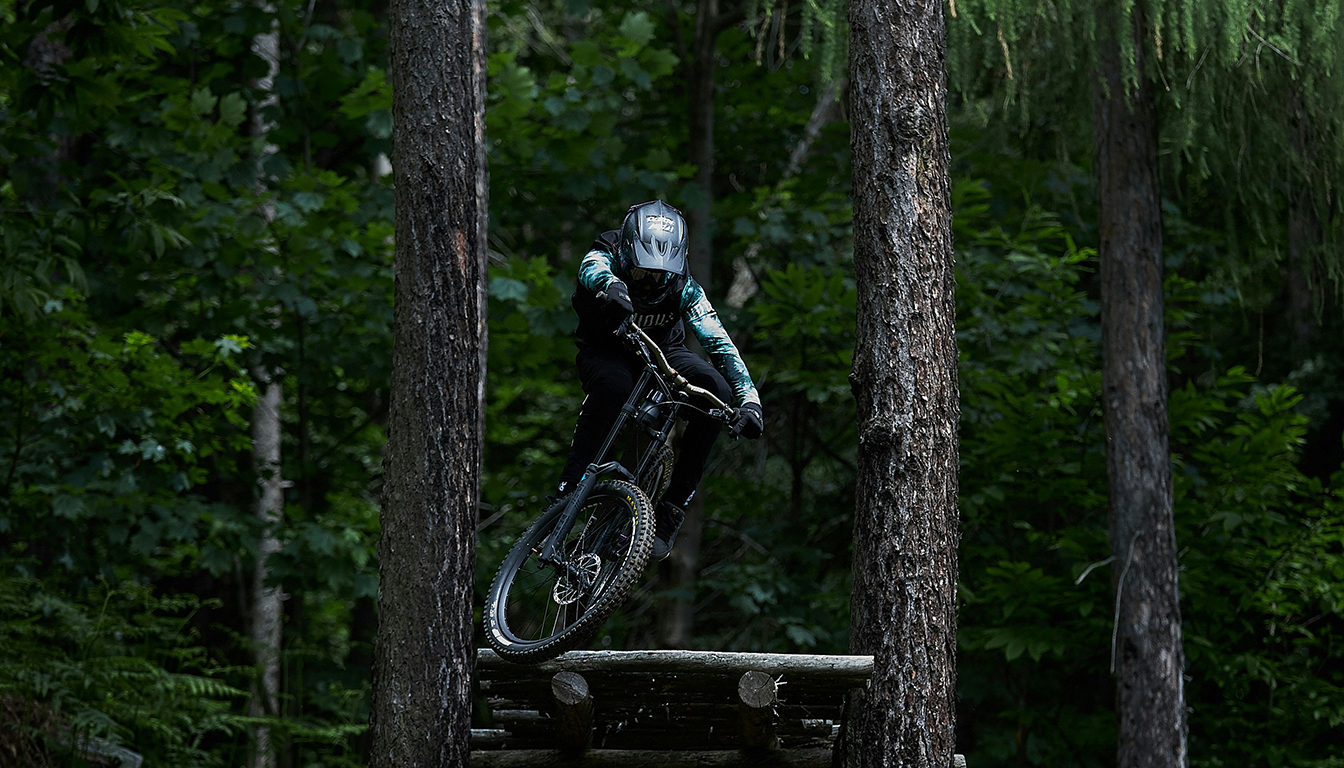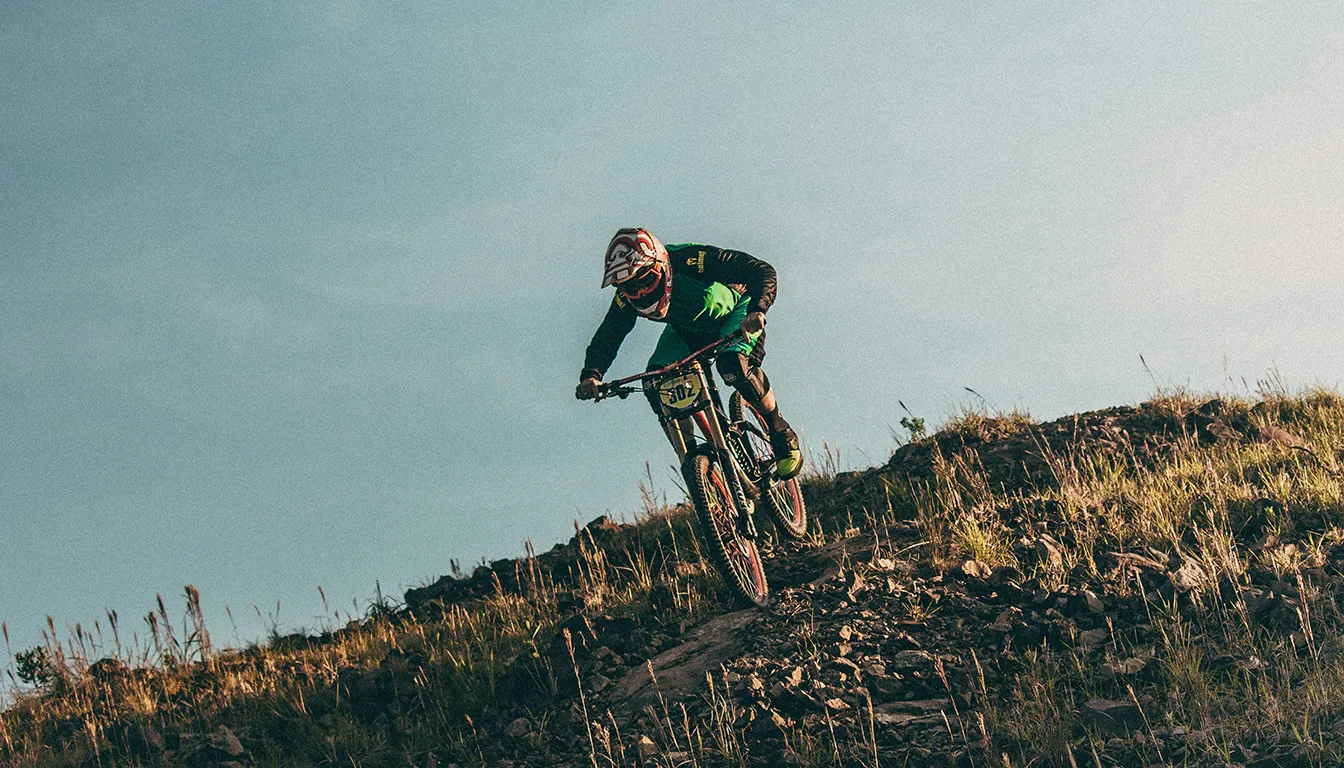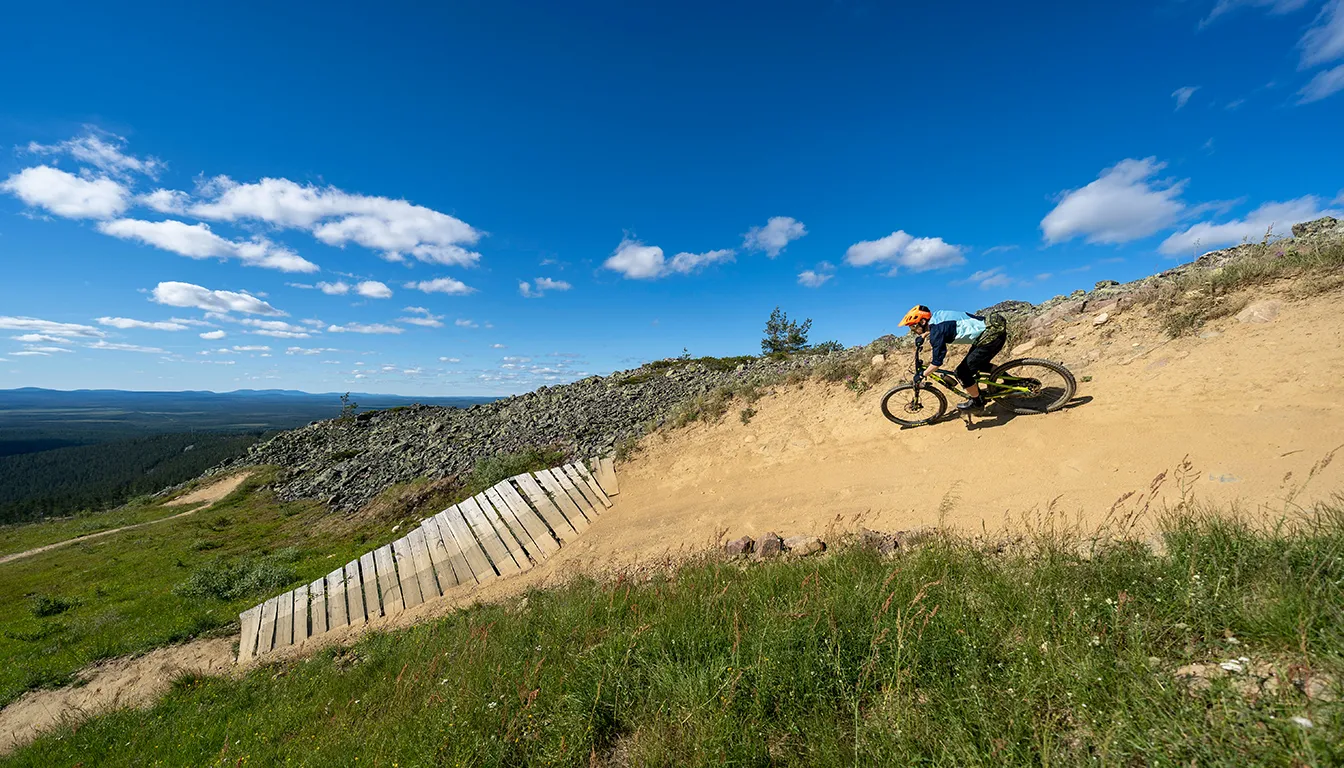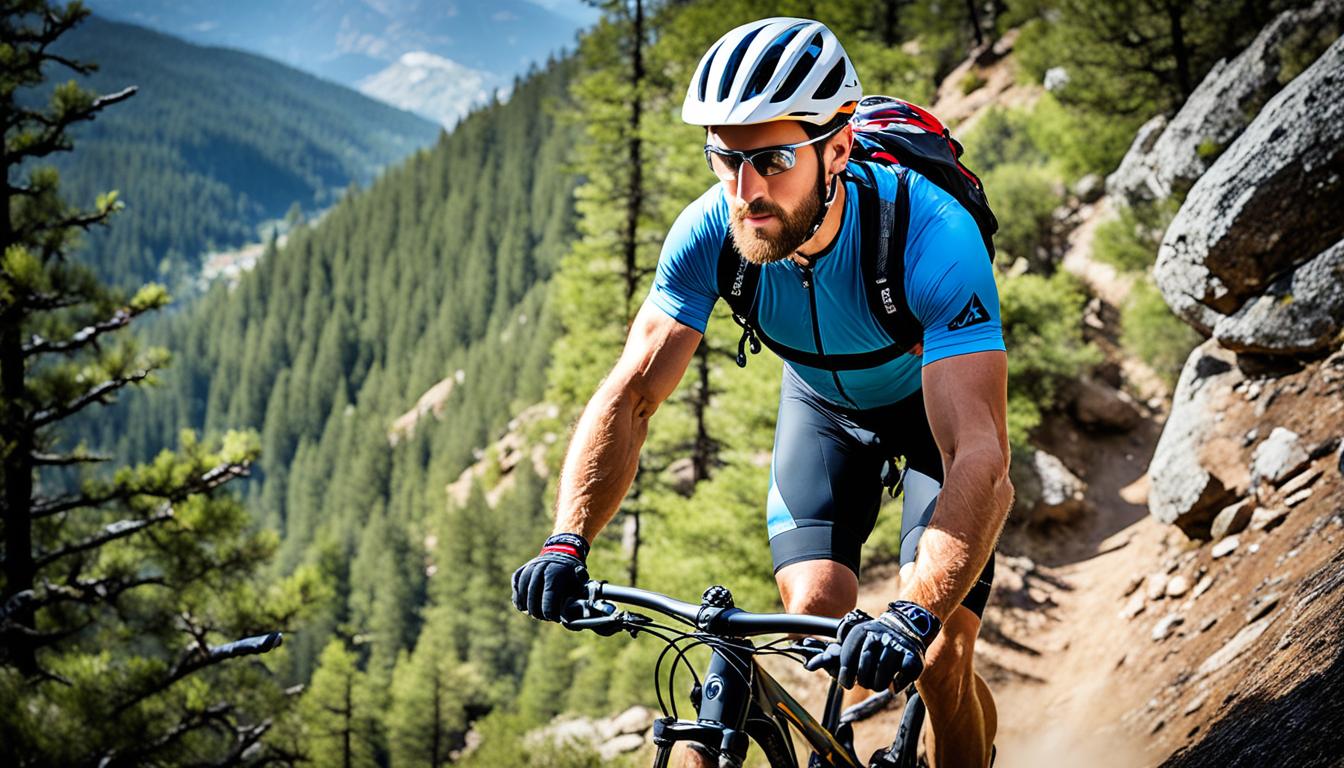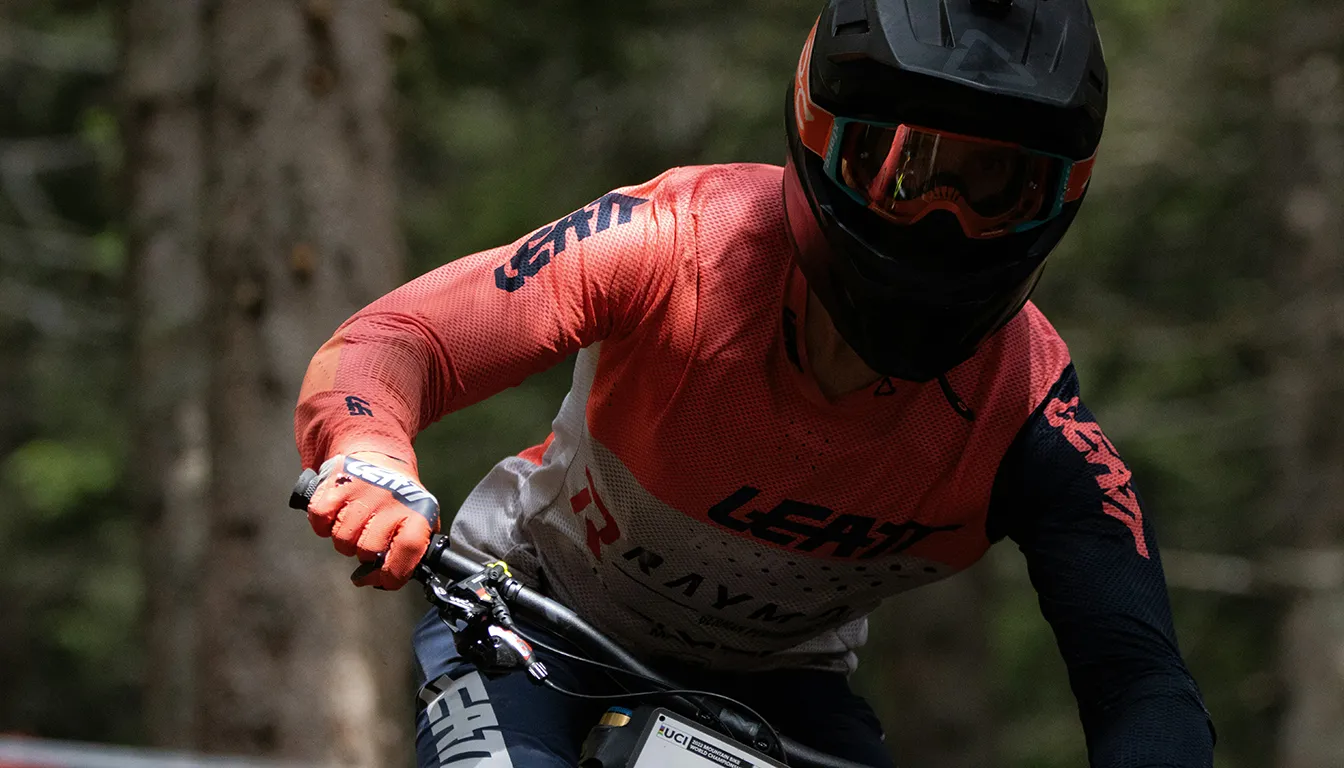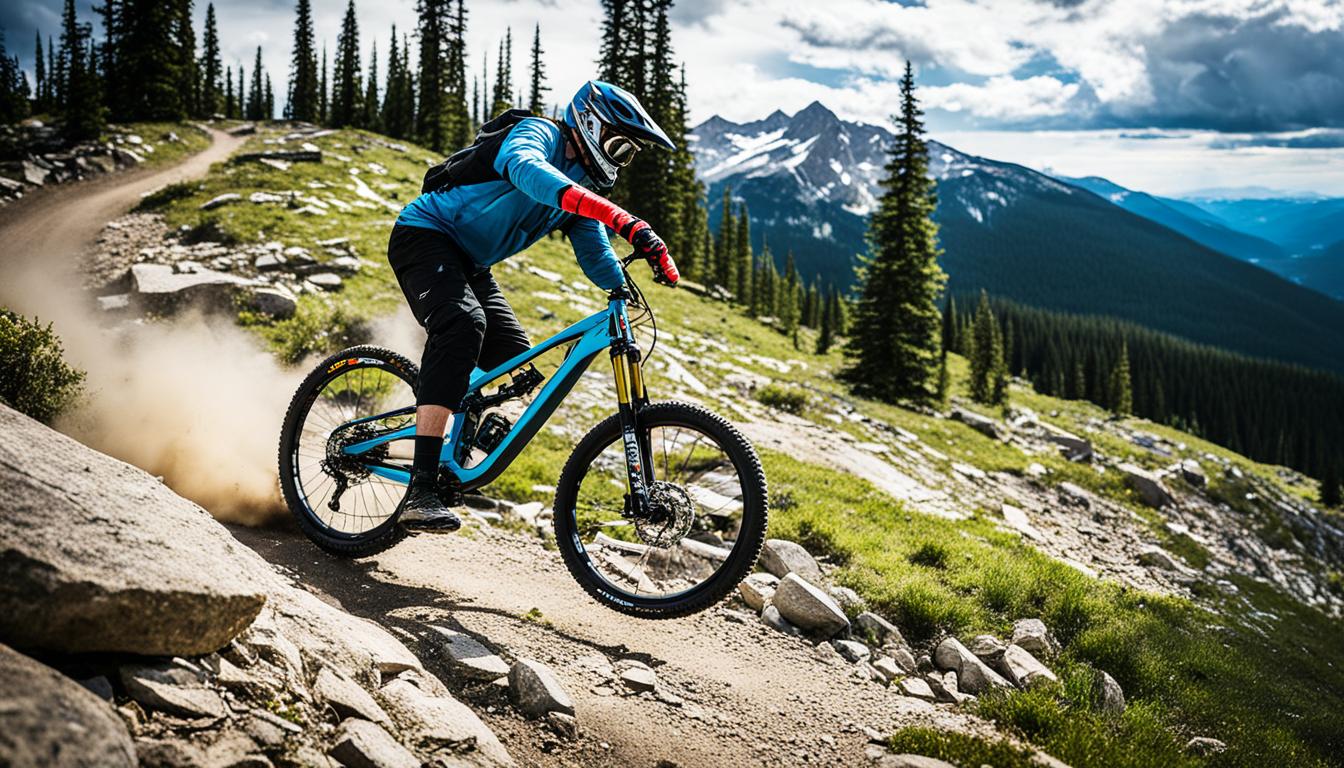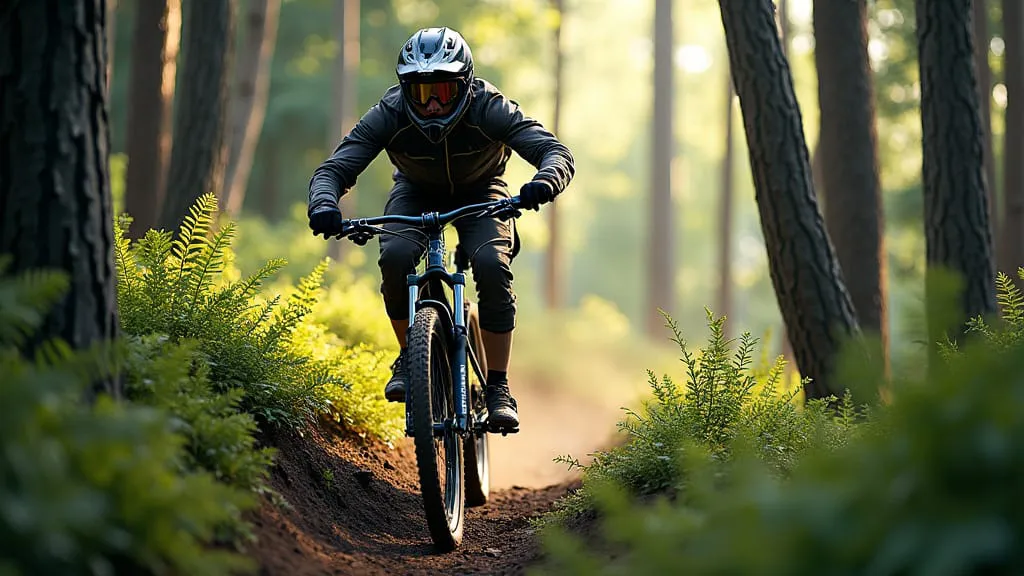Downhill mountain biking is exciting. It blends high speed with tough terrains, great for advanced riders. Mastering certain techniques is key. These include right body position, sharp brake control, and smart cornering. As you ride rough trails, knowing your bike well improves both performance and safety.
This guide offers top downhill biking tips. We focus on boosting skills and conditioning. Advanced riders using these methods face fewer accidents. Proper body positioning helps riders manage difficult terrains. It makes downhill biking more thrilling. We aim to help you tackle slopes with more confidence and skill.
The Evolution of Downhill Mountain Biking
The story of downhill mountain biking is both rich and varied. It demonstrates a remarkable journey from simple beginnings in the 1970s to today’s high-tech world. This evolution reflects the dedication of riders and the growth of bike technology.
Historic Overview of the Sport
Downhill mountain biking kicked off in the mid-1970s. Its inaugural time-trial race was in Fairfax, California, on October 21, 1976. In this event, ten riders braved a steep 1,300-foot descent down Repack Road in about five minutes. This race is a key moment in the history of downhill biking, paving the way for future competitions.
In 1990, downhill biking reached a significant milestone with the UCI Mountain Bike World Championships in Durango, Colorado. The sport then spread through Europe and the world. Famous sites like the “Planai” World Cup track in Schladming, Austria, became known for their tough courses and steep drops. These challenge even the best riders.
The Shift in Bike Technology
Bike technology has played a major role in shaping the sport. Early mountain bikes were just modified road bikes with basic parts. But in the 1990s, things like dual-crown forks and better suspension systems boosted performance. This let riders tackle harder terrains.
Lately, new advancements have changed biking for the better. The rise of medium-sized wheels, new frame styles, and improved suspension tech have made riding more exciting. This has drawn both hobbyists and top athletes, creating a thriving downhill biking community around the globe.
Essential Bike Setup for Downhill Mountain Biking for Advanced Riders
Setting up your bike for downhill is key for advanced riders looking to up their game on the trails. A bike that’s tuned right not only goes faster but also gives you better control when heading downhill. Knowing how to adjust your bike for the best downhill experience can make your rides both safer and more fun.
Importance of Bike Configuration
Every part of the bike plays a role in how it performs. Riders should focus on:
- Bike Size: A bike that fits well makes a big difference in comfort and control.
- Tyre Pressure: The right tyre pressure can improve grip and lower rolling resistance.
- Suspension Setup: For advanced riders, the right suspension settings can soak up bumps and improve grip.
- Handlebar and Brake Lever Positioning: Adjust these for your style and comfort.
Many experienced riders suggest learning from others or doing special courses to get your bike setup just right.
Adjusting Suspension and Tyres
Suspension settings for those at an advanced level need to balance sag and responsiveness. Starting points usually recommend:
- 30% sag for the rear shock
- 20% sag for the suspension fork
From there, you can tailor your setup. Adjust air pressure by 10 psi steps for the shock and 5 psi for the fork. Tweaking spring rate progress by adding or removing volume spacers in the air-spring chamber is also an option.
Mastering Body Position and Attention
Understanding body position in downhill biking boosts your trail performance. A good riding posture helps you handle obstacles smoothly. This makes you faster and more in control of the bike. Riders who want to level up should focus on their stance.
Optimal Riding Posture
An effective riding posture is key for skilled riders. Stand centred, with knees and elbows slightly bent and heels down. This position helps you tackle shocks and keep better balance. It leads to superior bike control during fast descents. Many who’ve been to coaching camps say getting your body position right greatly improves racing and confidence. For deeper insight, check out lessons on cornering techniques.
Keeping Your Eyes on the Trail
Staying focused means watching the trail ahead closely. Knowing what’s coming lets you adjust in time to keep stable and safe. Spot obstacles early for extra seconds to react. Keeping your head level helps your body respond smoothly to any changes. Doing well on the trails needs constant attention and understanding of your surroundings. This is key to moving safely and effectively.
Advanced Techniques for Cornering and Drops
Improving in mountain biking means getting better at advanced skills. This includes mastering cornering and drops. Learning these techniques will make you much better on tough trails. Aim for smooth transitions and keep control during complex moves.
Perfecting Cornering Skills
Getting better at cornering is crucial for handling turns well. Begin by lowering the outside pedal in a turn. This action lowers your centre of gravity and improves tyre grip. Keep your weight over the outside pedal to stay stable.
Lean the bike by extending your inside arm. At the same time, pull your outside grip towards your chest. Move your hips outwards to put more weight on the outer pedal. This helps the bike lean better.
Try to push down on the inner grip and pull up on the outer one to balance your weight. Practice turning at faster speeds to find out how much your bike can grip. If you slide, use your inside leg to stabilise the bike. Sometimes, aiming towards the corner’s outer edge for a few seconds helps with sliding wheels.
Moving your weight forward increases the front grip, which is good for control. When leaving the turn, pull up on the inside grip. Then straighten your hips and shoulders to stay balanced. These skills are useful when changing directions quickly.
Executing Drops with Confidence
Being confident with drops is key to getting better. Start with easy drops and slowly try higher ones. Approach drops at a good speed. Look ahead instead of down to improve your jump. Time your weight shift well; lean back as you drop off the edge. Get ready to bend your knees and elbows when you land.
Try different drop types to be more comfortable. Regular practice of each technique is needed for ease and precision. Improving at drops and cornering makes riding more fun.
For detailed tips on these skills, start with basic riding techniques. With hard work and practice, you’ll reach new heights in mountain biking.
Training Regimens for Enhanced Performance
To succeed in downhill biking, the right training is essential. Advanced riders focus on specific methods to get stronger and last longer. They use gym training tailored for biking, which gives a balanced workout suited for this thrilling sport.
The Role of Gym Training
Gym routines boost a rider’s performance notably. Activities like squats, deadlifts, and exercises for core stability are central. They support the needs of downhill biking by enhancing control and stamina. Emphasizing upper body strength, stamina, and functional fitness is vital. These elements sharpen riding skills and reduce injury risks.
Complementary Sports for Downhill Riders
Adding other sports benefits downhill biking. Cross-training, rock climbing, or martial arts enhance agility and core strength, aiding downhill riding. It’s advised to mix in flexibility exercises with strength training for the best results. High-intensity interval training plus weightlifting offers complete fitness boosts. By adjusting training with the seasons, riders improve their endurance and trail performance.
Thanks to mobile apps and programmes for biking fitness, riders can find exercises that match their targets. A personalised training plan can strengthen bones, improve joint health, and better posture. Both strength and skill training prepare riders to conquer trails confidently.
Conclusion
Downhill mountain biking is a sport full of challenges that require both commitment and skill. This article has given you tips on bike setup, body positioning, and advanced cornering. These tips aim to boost your downhill performance and deepen your love for the sport.
The excitement of downhill rides and competitive events has made the sport more popular globally. The number of events jumped from 23 in 2000 to 474 in 2013. Riders work hard to improve their skills for races that last between 2 to 5 minutes. This shows how the sport is always changing and growing, making it exciting at every level.
The adventure of downhill mountain biking tests both your mind and body. Research shows self-confidence and strong grip are key for doing well. This underlines the need for training that builds both mental and physical strength. Pushing your limits not only makes you better but also helps grow a community that loves this thrilling sport.
FAQ
What is the best way to set up my bike for downhill mountain biking?
To get the best performance, think about your bike size and tyre pressure. Also, adjust your suspension, handlebars, and brake levers to fit you. Getting these settings right makes downhill biking more enjoyable.
How can I improve my cornering skills in downhill mountain biking?
Good cornering needs balanced position and careful braking. Slow down before you turn, then speed up after. Try leaning the bike into corners while staying balanced. This helps make smooth turns.
Are there specific exercises that can enhance my performance as a downhill rider?
Indeed, focusing on strength, power, and endurance in the gym helps. Doing squats, deadlifts, and core exercises builds a strong base. This improves your downhill riding skills.
What makes body position important in downhill cycling?
A good position helps manage speed and control. Stay centred, with knees bent and elbows out. This way, you’ll absorb bumps better and control your bike easily on steep paths.
How did downhill mountain biking evolve over the years?
Downhill mountain biking started in the 1970s with “klunkers.” By the 1990s, new forks and suspensions were in. The sport got a big boost from the first UCI Mountain Bike World Championships in 1990.
Why is understanding my bike’s mechanics important?
Know your bike’s mechanics to improve your ride. It helps with handling and safety on tough paths. This makes biking down hills more thrilling.
How can gym training complement my downhill biking practice?
Gym workouts boost your biking by increasing strength, power, and endurance. This keeps your energy up and reduces injury risk. It makes you a better downhill biker.
